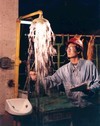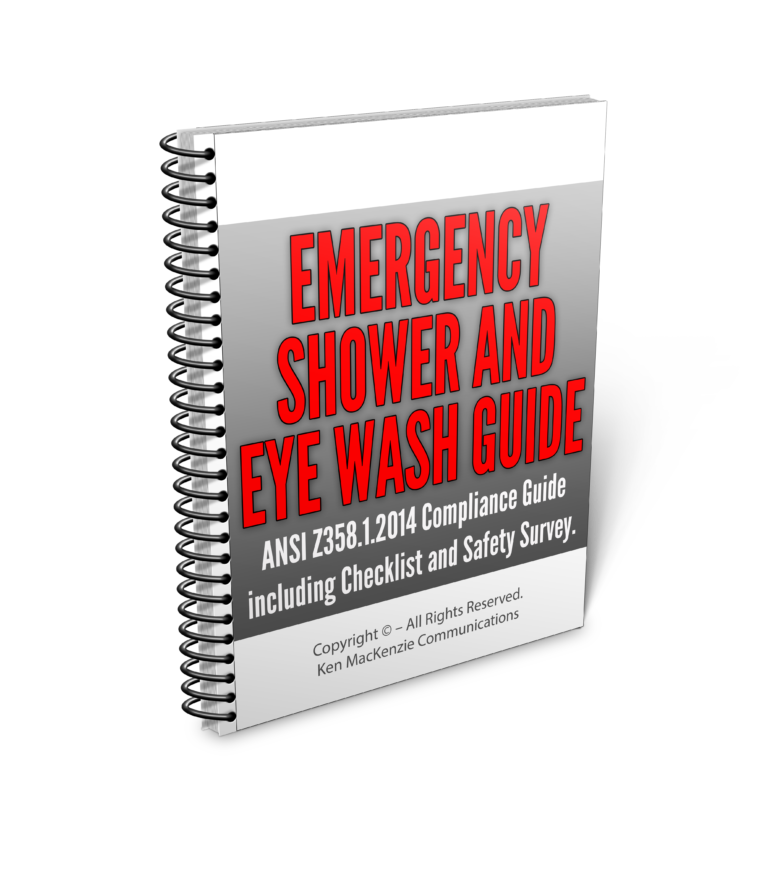 All personnel employed in the workplace must be instructed in emergency response including the location of and trained in the use of the emergency shower and/or eyewash station.
All personnel employed in the workplace must be instructed in emergency response including the location of and trained in the use of the emergency shower and/or eyewash station.
Emergency response equipment training
Written instructions should be made available to all personnel in the operation of the emergency shower and/or eyewash station. You should ensure that an emergency response instructional process includes a ‘hands-on’ drill to instruct employees on how to find and operate the emergency shower and eyewash station.
Simply installing emergency equipment does not mean you have assured worker safety.
It’s very important to develop an emergency response plan to be used if an accident does occur. The focus of the emergency response plan should be to assist the injured worker as quickly as possible.
It should never be assumed that workers are already aware of the proper procedures. Written instructions should be made available to all workers and posted beside the emergency shower and eyewash station. Part of the instructional process should include a “hands-on” drill on how to find equipment.
Wearing contact lenses can be dangerous because chemicals can become trapped under a contact lens. Any delays caused by removing contact lenses to rinse eyes could result in injury. Training should include instruction in contact lens removal.
There are some alarm systems on the market that can be installed in conjunction with emergency equipment and they serve to alert personnel and summon assistance if an eye wash or shower is activated.
It is recommended that alarm units be installed with any eye wash or emergency shower unit.
All workers/students who might be exposed to a chemical splash must be trained by their department or lab supervisor as part of their induction on the following:
• The specific location of the units serving that area.
• How to properly activate and use the specific type of system.
• Use of the eyewash station in the event of an eye injury.
Individuals should be instructed to hold the eyelids “open” and roll the eyeballs continuously so fluid will flow on all surfaces of the eye and under the eyelid and seek medical attention
 Eyewash and emergency shower equipment must be regularly maintained (including weekly inspection and activation of the equipment ) to ensure that it is in working order and inspected at least annually for compliance with the standard.
Eyewash and emergency shower equipment must be regularly maintained (including weekly inspection and activation of the equipment ) to ensure that it is in working order and inspected at least annually for compliance with the standard.
10-second rule Tip: If you were to ask any of your employees in your facility to locate the closest emergency shower or eye wash in their work area could they do so?
Remember, employees change and people are forgetful so make it a point to periodically remind workers of nearby safety equipment. Even the best emergency products won’t be able to serve their purpose if employees are unaware of where they are or how to use them. Emergency equipment training is essential!
For more information on Emergency Shower Training please click HERE
NOTE: People may not always be able to flush their eyes on their own because of intense pain.
Nearby helpers should be prepared to assist with holding the eyelids open. Other helpers may need to assist with keeping the person under the flushing fluid for at least 15 minutes.
• Use the safety shower in the event of a chemical spill onto their body. When cross-contamination has occurred, individuals should be instructed to remove all contaminated clothing, including footwear and socks/stockings, while under the shower.
Have someone assist with clothing removal when possible. An assistant may use a fire blanket or uncontaminated article of clothing as a shield to provide privacy for someone who needs to remove their clothes while under an emergency shower, and for body coverage while seeking medical attention.
• Flush the body for a minimum of 15 minutes, and seek medical attention.
It should never be assumed that workers are already aware of the proper procedures. Written instructions should be made available to all workers and others and posted beside the emergency shower and eyewash station.
Part of the instructional process should include a “hands-on” drill on how to find equipment.
Contact lens wear can be dangerous because chemicals can become trapped under them. Any delays caused by removing contact lenses to rinse eyes could result in injury. Training should include instruction in contact lens removal.
Signage:
The location of each emergency shower or eyewash station shall be well illuminated and be identified with a highly visible sign visible throughout the area served by the equipment. The sign should be in the form of a symbol that does not require workers to have language skills to understand it. The location should be well lit.
Occupational Safety and Health Administration
All workers require instruction in the proper use and location of emergency showers or eyewash stations before any emergencies occur. It should never be assumed that workers are already aware of the proper procedures. Written instructions should be made available to all workers and posted beside the emergency shower and eyewash station. Part of the instructional process should include a “hands-on” drill on how to find equipment.
The wearing of contact lenses can be dangerous because chemicals can become trapped under a contact lens. Any delays caused by removing contact lenses to rinse eyes could result in injury. Training should include instruction in contact lens removal.

